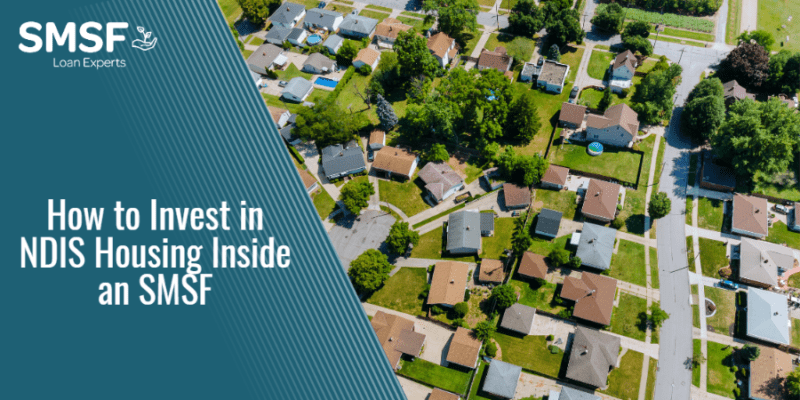Investing in NDIS (National Disability Insurance Scheme) properties through a self-managed super fund (SMSF) is becoming popular among property investors seeking both financial returns and social impact.
NDIS property investments offer rental income supplemented by the Australian Government through payments through the tenants NDIS plan. The niche nature of NDIS properties, combined with the regulatory structure of SMSFs, requires careful consideration.
In this article we discuss the potential benefits, risks, and considerations for investing in NDIS properties within an SMSF.
Why Consider NDIS Property for SMSFs?
NDIS properties, known as specialist disability accommodation (SDA), are designed to meet the specific needs of people with disability, creating a housing solution for vulnerable members of the community. Here are some reasons why NDIS property is being chosen by SMSF investors:
- SDA payments: To increase supply in the much-needed SDA property market, the government provides property investors with SDA payments on top of the reasonable rent contribution paid by the tenant. This means the tenant gets access to a purpose-built home for an affordable price, while the SDA payments through the NDIS mean that rental returns are typically above market rates.
- Long-term tenancies: NDIS participants often require long-term, stable housing, leading to lower vacancy rates compared to standard investment properties.
- Social impact: Investing in NDIS properties allows SMSF trustees to contribute to community needs by helping provide quality, accessible housing for people with disability.
While NDIS property investment offers these benefits, SMSF trustees must navigate several unique complexities to ensure compliance and effective management.
SMSF and NDIS Property Compliance Requirements
SMSF trustees must follow the Superannuation Industry Supervision Act (SIS Act) and regulations regarding allowable investments, fund purpose, and property usage.
- Sole purpose test: SMSFs must exist solely to provide retirement benefits for members. Trustees cannot live in or personally use NDIS properties, as this would violate the sole purpose test.
- Related party transactions: If a related party is involved in managing or providing services to the NDIS property, all transactions must be conducted on an arm’s length basis to avoid conflicts of interest.
- Borrowing considerations: SMSFs can borrow to purchase NDIS property through limited recourse borrowing arrangements (LRBAs), but trustees should consider loan obligations and cash flow to ensure the SMSF can meet loan repayments. Due to the higher rental income, NDIS properties are often cash flow positive investments. This means that the income generated by the property may cover the loan repayments (if the property is occupied).
Benefits of NDIS Property in SMSFs
Enhanced Rental Yields
NDIS properties qualify for government SDA funding, which may significantly boost rental yields compared to standard residential properties. This funding can make NDIS property investments financially rewarding within an SMSF structure. However, it requires the property to be enrolled as SDA property, as well as be occupied by an NDIS participant.
Demand
The need for quality, disability-accessible housing is high, and the government’s commitment to supporting people with disability indicates that demand will likely remain stable. The government is committed to reducing the number of young people with disability living in aged care — while SDA is helping, there is still a long way to go.
Diversification for SMSF Portfolios
Investing in NDIS properties allows SMSFs to diversify their asset base, adding a unique class of real estate that balances social impact with potential returns.
Tax Efficiency
SMSFs enjoy concessional tax treatment on investment income and capital gains, especially if the property is held until the fund enters the pension phase, where taxes on rental income and capital gains can be significantly reduced or even eliminated.
Challenges of Investing in NDIS Property Within an SMSF
While the benefits are compelling, NDIS properties come with specific challenges that SMSF trustees should be aware of.
Higher Entry Costs and Development Standards
NDIS properties must meet SDA design standards, which often makes them more expensive to build or buy than standard investment properties. Trustees should be prepared for these higher costs, and carefully review the construction and compliance requirements involved.
Niche Market
NDIS properties cater to a niche market, and although demand is high, it’s still limited to eligible NDIS participants. A shortage of suitable tenants could lead to longer vacancy periods, impacting rental income. Engaging with reliable SDA property managers who specialise in tenant placement is essential to ensure consistent occupancy. It’s also important to build NDIS properties in an area with high demand.
Liquidity Constraints
Property investments in general have low liquidity, and NDIS properties can be even more challenging to sell, given their specialised nature. SMSF trustees should ensure they have sufficient liquidity within the fund to meet potential obligations, such as benefit payments to members, without being forced to sell the property at an inopportune time.
Is NDIS Property Right for Your SMSF?
Investing in NDIS property within an SMSF may offer a blend of financial and social benefits, making it appealing to trustees who value both. However, due to its unique nature and compliance requirements, it’s important to work with the right NDIS property specialists.
If you’re considering adding an NDIS property to your SMSF portfolio, we can put you in touch with the right people. Reach out to us today to learn more.







